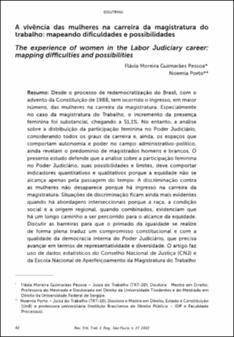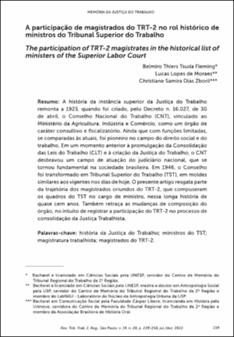Artigo de periódico
A vivência das mulheres na carreira da magistratura do trabalho: mapeando dificuldades e possibilidades
| dc.contributor | Pessoa, Flavia Guimarães | |
| dc.contributor | Porto, Noemia | |
| dc.date.accessioned | 2022-05-06T16:05:37Z | |
| dc.date.available | 2022-05-06T16:05:37Z | |
| dc.date.issued | 2022-05-23 | |
| dc.identifier.citation | PESSOA, Flavia Moreira Guimarães; PORTO, Noemia. A vivência das mulheres na carreira da magistratura do trabalho: mapeando dificuldades e possibilidades = The experience of women in the Labor Judiciary career: mapping difficulties and possibilities. Revista do Tribunal do Trabalho da 2ª Região, São Paulo, v. 14, n. 27, p. 42-62, 2022. | pt_BR |
| dc.identifier.uri | https://basis.trt2.jus.br/handle/123456789/14734 | |
| dc.description.abstract | [por] Desde o processo de redemocratização do Brasil, com o advento da Constituição de 1988, tem ocorrido o ingresso, em maior número, das mulheres na carreira da magistratura. Especialmente no caso da magistratura do Trabalho, o incremento da presença feminina foi substancial, chegando a 51,1%. No entanto, a análise sobre a distribuição da participação feminina no Poder Judiciário, considerando todos os graus da carreira e, ainda, os espaços que comportam autonomia e poder no campo administrativo-político, ainda revelam o predomínio de magistrados homens e brancos. O presente estudo defende que a análise sobre a participação feminina no Poder Judiciário, suas possibilidades e limites, deve comportar indicadores quantitativos e qualitativos porque a equidade não se alcança apenas pela passagem do tempo. A discriminação contra as mulheres não desaparece porque há ingresso na carreira da magistratura. Situações de discriminação ficam ainda mais evidentes quando há abordagens interseccionais porque a raça, a condição social e a origem regional, quando combinados, evidenciam que há um longo caminho a ser percorrido para o alcance da equidade. Discutir as barreiras para que o primado da igualdade se realize de forma plena traduz um compromisso constitucional e com a qualidade da democracia interna do Poder Judiciário, que precisa avançar em termos de representatividade e diversidade. O artigo faz uso de dados estatísticos do Conselho Nacional de Justiça (CNJ) e da Escola Nacional de Aperfeiçoamento da Magistratura do Trabalho (ENAMAT), incluindo a pesquisa que é resultado da parceria da ENAMAT com o IPEA. A apresentação de dados dialoga com reflexões da doutrina escrita por mulheres. | pt_BR |
| dc.description.abstract | [eng] Since the process of redemocratization in Brazil, with the advent of the 1988 Constitution, there has been a greater number of women entering the career of the judiciary. Especially in the case of the Labor judiciary, the increase in the female presence was substantial, reaching 51.1%. However, the analysis of the distribution of female participation in the Judiciary, considering all career levels and also the spaces that include autonomy and power in the administrative-political field, still reveal the predominance of male and white magistrates. The present study argues that the analysis of female participation in the Judiciary, its possibilities and limits, must include quantitative and qualitative indicators because equity is not achieved only by the passage of time. Discrimination against women does not disappear because there is a career in the judiciary. Situations of discrimination are even more evident when there are intersectional approaches because race, social status and regional origin, when combined, show that there is a long way to go to achieve equity. Discussing the barriers for the primacy of equality to be fully realized reflects a constitutional commitment and with the quality of the internal democracy of the Judiciary, which needs to advance in terms of representativeness and diversity. The article makes use of statistical data from the National Council of Justice (CNJ) and the National School for the Improvement of the Judiciary of Labor (ENAMAT), including research that is the result of the partnership between ENAMAT and IPEA. The presentation of statistic data dialogues with reflections on the doctrine written by women. | pt_BR |
| dc.language.iso | pt_BR | pt_BR |
| dc.relation.ispartof | Revista do Tribunal do Trabalho da 2ª Região: v. 14, n. 27 (jan./jun. 2022) | pt_BR |
| dc.subject | Artigo de periódico | pt_BR |
| dc.subject | Carreira | pt_BR |
| dc.subject | Discriminação | pt_BR |
| dc.subject | Equidade | pt_BR |
| dc.subject | Igualdade de oportunidades | pt_BR |
| dc.subject | Justiça do trabalho | pt_BR |
| dc.subject | Magistratura | pt_BR |
| dc.subject | Mulher | |
| dc.subject | Relações de gênero | |
| dc.title | A vivência das mulheres na carreira da magistratura do trabalho: mapeando dificuldades e possibilidades | pt_BR |
| dc.title.alternative | The experience of women in the Labor Judiciary career: mapping difficulties and possibilities | pt_BR |
| dc.type.genre | Artigo de periódico | pt_BR |
| dc.type.material | Documento textual | pt_BR |
| dc.relation.ispartoflink | https://basis.trt2.jus.br/handle/123456789/14727 |
Coleção
-
Artigos de Periódicos132
Artigos de Periódicos








